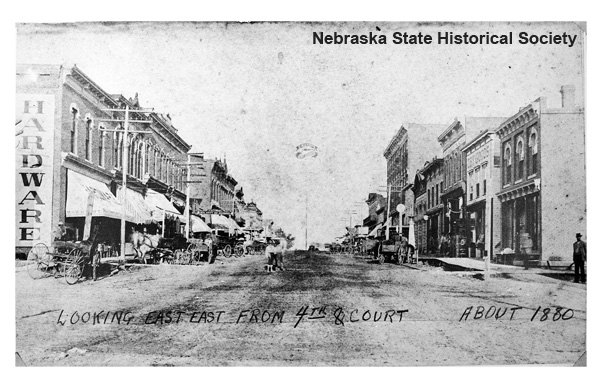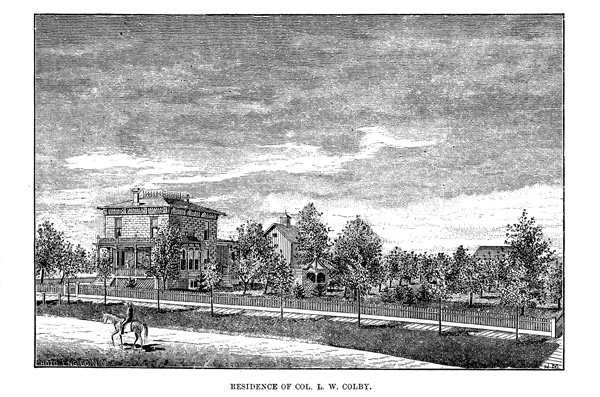How does one transform a prairie town into a thriving cultural center? When a town desires to strengthen the moral fiber of its citizens, protect its young people from vice, and attract the “most desirable class of people” what route does it take? In the early 1870s, those were the questions that the people of Beatrice wanted to answer. Each of them had moved west with their own dreams and ambitions. Many of them held idealized visions of the healthy, thriving city that they intended to forge out of the prairie grass. But what they felt was the most useful asset for their young town may come as a surprise because today we take it for granted: a public library.
Kristin Mapel Bloomberg’s article in the newest Nebraska History follows the leading Beatrice citizen Clara Bewick Colby and others in their efforts to unite the community to “establish and maintain a public library, a free reading-room, and a museum of antiquities and natural history.” At this time in history, many western cities and towns did not have government-run public libraries. Their collections consisted entirely of the efforts of the citizens. A public library would be the symbol of the progressive, mentally and culturally mature society that the citizens of Beatrice desired. Colby and other women of the community founded the “Ladies Library Association of Beatrice,” which solicited donations, held fundraisers, and used Colby’s connection with the local newspaper to advertise the library as a source of wholesome entertainment in Beatrice.

Beatrice, circa 1880 – RG4396-13-67 (above).
However, the founding of such an institution was not without controversy. Some members of the Library Association and Beatrice community believed that the library should house all texts classic and contemporary, showing Beatrice’s desire to be modern. Others were dismayed that the library was not more selective in its works. One such controversial piece was the then-recent The Origin of Species (1859) by Charles Darwin. Colby’s grandmother, Clara Chilton, was perhaps the most outspoken in her belief that the library should only contain books that were concordant with Christian teachings. She stated:
“I find that your library affair is successful but disapprove of some of the selections, the present reading matter for the young is not at all calculated to improve their minds or lead them one step heavenward to know the way . . . Darwin for instance is not so dangerous (at least not to me) because no person with any sense would believe his dogmas, but the more crafty works of Satan are to be avoided.”
Thus, the library became not only a social conversation but a moral one as well. As a private institution, the Library Association was at liberty to choose whichever books it desired. The library and reading room were promoted mostly through the presumed beneficial effects they would have on the community; many upstanding citizens in Beatrice felt compelled to provide a wholesome source of entertainment for young people, in opposition to saloons. It soon became clear that some agreed with Grandma Chilton’s concerns about the literature when controversial texts were found to be missing.

This picture (above) appeared in a book by A.T. Andreas, labeled as the Colby residence. However, it is unlikely that this is what the house actually looked like at the time, and is more likely an idealized version of what Beatrice residents desired their town to look like.
Unfortunately, with or without the controversial material, the Library Association’s work would be short-lived. Several years later, the library was forced to close from lack of funds. This was largely due to competition from a second privately owned library, which, ironically, closed soon after the first. It wasn’t until 1893, when a government-run library was established, that Beatrice had a permanent public library.
What is the duty of a society to its young people, and the morality of its people? It isn’t only parents who raise children, but also their teachers, neighbors, and community . How should a community go about training its youth to become moral, wise citizens? The story of the Beatrice library has a perhaps disappointing ending in that it does not answer these questions, which we are still asking today. We want there to be no restrictions on our freedoms to say, read, and do whatever we desire; but we also want our young people to have clean mouths, not to fill their heads with nonsense, and to refrain from acting out the violence they see on TV. At the same time we do not want them to be ignorant about the ways of the world, and want them to be able to discover things for themselves. In many ways, the questions Beatrice was asking 150 years ago are the same questions we have for our own communities; ones that haven’t really been answered yet by America.
–Joy Carey, Editorial Assistant, Publications



